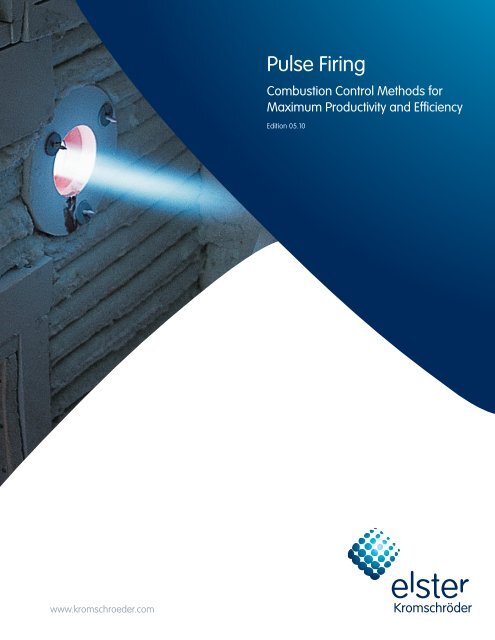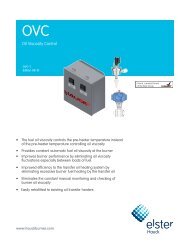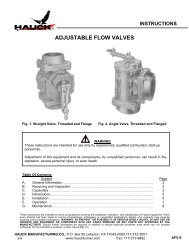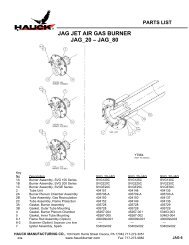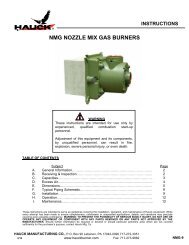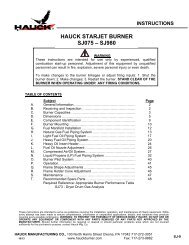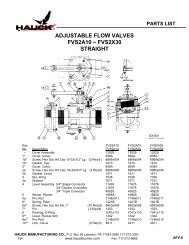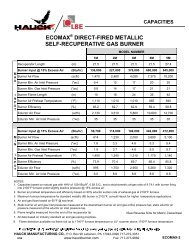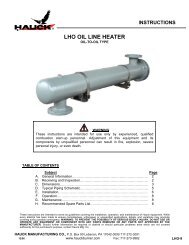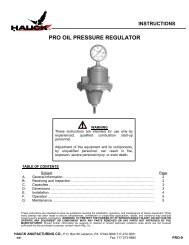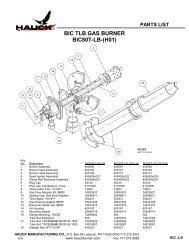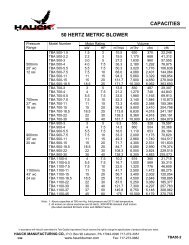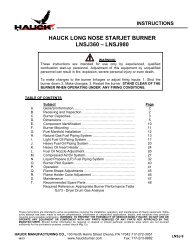Pulse Firing - Hauck Manufacturing
Pulse Firing - Hauck Manufacturing
Pulse Firing - Hauck Manufacturing
Create successful ePaper yourself
Turn your PDF publications into a flip-book with our unique Google optimized e-Paper software.
<strong>Pulse</strong> <strong>Firing</strong><br />
Combustion Control Methods for<br />
Maximum Productivity and Efficiency<br />
Edition 05.10<br />
www.kromschroeder.com
2 · <strong>Pulse</strong> <strong>Firing</strong> · Edition 05.10<br />
Benefits of <strong>Pulse</strong> Fired Control<br />
Systems<br />
Typical <strong>Pulse</strong> Fired System<br />
solenoid valve with<br />
integrated pulse regulator<br />
ball<br />
valve<br />
solenoid<br />
valve<br />
limiting<br />
orifice<br />
high fire<br />
bellows<br />
unit<br />
burner<br />
air butterfly<br />
valve<br />
limiting<br />
orifice<br />
high fire<br />
to other<br />
burners<br />
<strong>Pulse</strong> <strong>Firing</strong> is a specialized type of combustion<br />
system control that offers significant<br />
process and productivity benefits.<br />
– Fuel savings<br />
– Improved temperature uniformity<br />
– Lower NOx emissions<br />
– Versatile control schemes<br />
– Improved turndown<br />
– Suitable for heating and cooling cycles<br />
Fuel Savings<br />
With the burners operating on-ratio and at<br />
their most efficient firing setting (high fire),<br />
ideal operating conditions are achieved for<br />
maximum heat transfer with minimal fuel input.<br />
Improved Temperature Uniformity. <strong>Pulse</strong><br />
fire control facilitates the highest level of convective<br />
heat transfer to the load and mixing of<br />
atmosphere within the furnace chamber by<br />
firing the burners at their highest exit velocity.<br />
This results in superior temperature uniformity<br />
and the highest product quality.<br />
Lower Emissions<br />
Because the high velocity burners of pulse<br />
fired systems operate at high fire with low<br />
excess air, NOx emissions are minimized as<br />
the high velocity flame entrains the maximum<br />
amount of furnace gases for more complete<br />
mixing and lower peak flame temperatures.<br />
Control Design Flexibility<br />
A pulse fired system can be designed to accommodate<br />
even the most stringent temperature<br />
uniformity and application requirements<br />
allowing maximum system turndown<br />
to be achieved whether your furnace hold<br />
temperature is 800ºF or 2300ºF.<br />
Maximized Productivity<br />
By utilizing the system’s burners at their<br />
most efficient firing rates, maximum energy<br />
is transferred to the furnace load in the least<br />
amount of time resulting in improved productivity.<br />
25% Heat Demand<br />
A1<br />
A2<br />
25 %<br />
A3<br />
A4<br />
A typical four-burner system with a set high<br />
fire time of six seconds would be represented<br />
as shown in Figure 3. At any point, one of<br />
the four burners (25%) is at high fire, with<br />
the remaining three burners at low fire or off.<br />
50% Heat Demand<br />
A1<br />
A2<br />
50 %<br />
A3<br />
A4<br />
As the heat demand increases from 25% to<br />
50%, the same four-burner system would<br />
now look as shown in Figure 4. Two of the<br />
four burners (50%) are now at high fire at any<br />
point in the cycle. These are typical examples.<br />
Our experience has shown that many<br />
applications require custom firing solutions<br />
to meet specific production requirements.<br />
<strong>Pulse</strong> <strong>Firing</strong> and Burner<br />
Geometry<br />
<strong>Pulse</strong> firing control maximizes the advantages<br />
of High Velocity Burners and burners<br />
designed for specific flame geometry.<br />
<strong>Pulse</strong> firing enhances tube temperature<br />
uniformity extending the tube life of Radiant<br />
Tube Burners.<br />
Flat Flame Burners can be operated at maximum<br />
pressure and maintain their designed<br />
flame shape.<br />
On-off pulse fired control is the required<br />
method of firing for modern Self-Recuperative<br />
Burner systems.
<strong>Pulse</strong> <strong>Firing</strong> · Edition 05.10 · 3<br />
Robust burners and controls<br />
designed for the high cycle<br />
demands of pulse fi ring.<br />
Burners<br />
<strong>Pulse</strong> fi ring control maximizes the technological<br />
advancements of high velocity burners<br />
like the <strong>Hauck</strong> SVG burner and BIC/BIC..L<br />
burner from Kromschroder as well as the<br />
unique fl ame geometry characteristics of the<br />
<strong>Hauck</strong> WHG and RFG burners.<br />
High Velocity SVG<br />
our own. From valves, regulators, fl ame safety<br />
and burner control units, <strong>Hauck</strong> has the<br />
full array of Kromschroder controls to meet<br />
the control requirements of your specifi c application.<br />
High Cycle Air/Gas Valves<br />
Kromschroder BVHM/MB , VR Air Solenoid,<br />
VAS Gas Solenoid<br />
<strong>Pulse</strong> Ratio Regulator<br />
Kromschroder GIK, VAG Combination Valve<br />
VAG<br />
SVG Burner<br />
– Refractory, ceramic and alloy tile options<br />
– Low emissions (NOx, VOCs and aldehydes)<br />
Kromschroder BIC..L<br />
– GIK maintains constant air/gas ratio<br />
over wide turndown ranges<br />
– VAG has integrated safety valve in an<br />
all-purpose regulator for ease of installation<br />
with minimal space requirement<br />
Flame Safety Options<br />
BIC..L<br />
– High exit velocity<br />
– Wide performance range<br />
– Available in extended lengths<br />
Flat Flame WHG<br />
– Flat fl ame profi le throughout entire fi ring<br />
range, even when pulse-fi red<br />
– Even heat distribution with no fl ame impingement<br />
Radiant Tube RFG<br />
– Designed for use with RADimax recuperator<br />
for maximum effi ciency<br />
– Excellent fl ame stability and tube temperature<br />
uniformity<br />
Controls<br />
Kromschroder controls are designed to handle<br />
the high cycle demands of pulse fi ring<br />
operation and have been used successfully<br />
with many competitor‘s burners as well as<br />
19” Rack<br />
Kromschroder BCU, PFU 19” Rack System,<br />
IFD 258<br />
– BCU features ignition transformer, display,<br />
indicators and operating controls in<br />
a compact unit<br />
– IFD offers fl ame control with diverse installation<br />
possibilities<br />
– PFU provides a 19-inch rack system for<br />
control panels when combined with MPT<br />
impulse controller and is ideal for pulse<br />
fi ring<br />
<strong>Pulse</strong> Logic Controls<br />
Kromschroder MPT-700 (installed in PF-19” Rack<br />
System) or PLC based systems<br />
– Converts controller signals to pulse cycles<br />
for gas burners<br />
– Linear ratio between controller signal<br />
and burner capacity
What is <strong>Pulse</strong> <strong>Firing</strong>?<br />
<strong>Pulse</strong> firing is a firing method for a multiple<br />
burner combustion system. <strong>Pulse</strong> firing<br />
controls thermal input by cycling burners<br />
between two settings, high and low or high<br />
and off, to meet the required heat demand.<br />
An air solenoid valve at each burner with<br />
adjustable minimum and maximum settings<br />
replaces the typical linkage controlled modulated<br />
zone air valve. If cycling burners high<br />
to low, low fire gas input is set via a bypass<br />
in or around the pulse regulator.<br />
The burner is ignited at low fire. Each time the<br />
air solenoid is energized, the burner switches<br />
from low fire to high fire operation. This uses<br />
the entrainment and stirring action benefits<br />
of high velocity burners to their best advantage.<br />
Also, since the air and fuel piping to<br />
each burner is identical, changing the pulsing<br />
sequence or even moving a burner from one<br />
zone to another is all done electronically as<br />
opposed to mechanically which simplifies air<br />
and gas piping requirements.<br />
<strong>Hauck</strong> <strong>Manufacturing</strong> Company<br />
Kromschroeder Controls<br />
PO Box 90<br />
Lebanon, PA 17042<br />
United States<br />
T +1 717-272-3051<br />
info@hauckburner.com<br />
www.hauckburner.com<br />
www.elster.com<br />
www.kromschroeder.com<br />
Copyright © 2007 – 2010 Elster Group<br />
All rights reserved.


